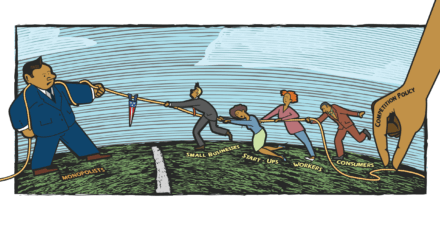Kate Bahn testimony before the Select Committee on Economic Disparity and Fairness in Growth on imbalance of power
Kate Bahn
Washington Center for Equitable Growth
Testimony before the Select Committee on Economic Disparity and Fairness in Growth, Hearing on “(Im)Balance of Power: How Market Concentration Affects Worker Compensation & Consumer Prices”
April 6, 2022
Thank you, Chair Himes, Ranking Member Steil, and members of the Select Committee on Economic Disparity and Fairness in Growth, for inviting me to testify today. My name is Kate Bahn, and I am the director of labor market policy and the chief economist at the Washington Center for Equitable Growth. We seek to advance evidence-backed ideas and policies that promote strong, stable, and broad-based growth. Core to this mission is understanding the ways in which inequality has distorted, subverted, and obstructed economic growth in recent decades.
As the economy swiftly recovers from the economic crisis caused by the coronavirus pandemic, now is the time to leverage recent gains in the U.S. labor market to address longstanding deleterious trends of income inequality and wage stagnation for most workers. Mounting evidence from cutting-edge research in economics, which I will review today, demonstrates how the rising concentration of corporate power is a significant cause of these trends. Furthermore, rebalancing power toward workers and diminishing the power of companies to undercut wages will lead to more efficient outcomes, with growing incomes and higher employment levels, strengthening economic growth that is shared by all.
Introduction
Despite being one of the largest and wealthiest economies in the world, trends of rising income inequality and wage stagnation in the United States are evidence of a market failure. The hypothetical free market has dominated economic narratives because it tells an optimistic story: that competitive forces will ensure resources are located efficiently and workers are paid equivalent to the value they contribute. But economic evidence demonstrates this is not the world we live in.
High inequality in the United States results in an inefficient allocation of talent and resources while increasing corporate concentration that enriches the few as it also holds back the entire economy from its potential. Understanding the factors that lead to an intrinsically noncompetitive U.S. labor market and the forces that have allowed corporations to take advantage of this are key to crafting effective policy solutions.
To further examine the structural factors that have led to these economic conditions, policymakers need to understand an economic concept called monopsony. It sounds like the product market equivalent of the better-known concept of monopoly, but here, single buyers exert price-setting power instead of single sellers. As in a monopoly, this phenomenon is not limited to when a firm is strictly the onlybuyer of labor, but rather any time a buyer firm is able to engage in anticompetitive conduct or simply take advantage of noncompetitive features of a market to set prices—in this case, wages—lower than they would be in a hypothetical market where it would have to compete against other purchasers. Today, I will explain the circumstances and effects of employers having significant monopsony power over the market and over workers.
Monopsony is most commonly understood as a labor market phenomenon, though it also is present in markets for intermediary suppliers. Fundamentally, workers who sell their labor are different than other things that are bought and sold on the market. They are what Karl Polanyi referred to as a “fictitious commodity,” meaning labor itself is not made for the market but must be structured and conceptualized to align with market forces. In order to find employment, workers:
- Need information about the jobs available and their attributes, and whether they align with workers’ talents and interests
- Need to commute to work or move to a new location for a job
- Must balance their work hours with other demands in their lives
- Need to have a variety of job options from which to choose
Each of these things make up what economists call “labor market frictions,” and their inherent existence in the employee-employer relationship gives companies the ability to undercut wages without losing their entire workforce—which evidence suggests they readily do.
One recent survey of all the economic research on monopsony finds that, on average across studies, employers have the power to keep wages more than one-third lower than they would be in a perfectly competitive market. Put another way, in a theoretical competitive market, if an employer cut wages, then all workers would quit because other suitable employers would be competing to hire them, too. But in reality, these estimates are the equivalent of a firm cutting wages by 5 percent and only losing 10 percent to 20 percent of their workers.
These firm-level dynamics impact the entire structure of the U.S. economy. In one calculation with data from the United States, it was estimated that reducing firm-level monopsony power by one standard deviation would reduce overall earnings inequality by 9 percent. Another estimation finds that monopsony reduces the labor share of national income by 22 percent, which is quite a large impact.
The U.S. economy is in a unique moment to address these longstanding structural features. The unprecedented economic shock caused by the coronavirus pandemic has been followed by a rapid recovery in the U.S. labor market, with employment nearing its pre-pandemic levels and wage growth being experienced by low-wage workers, non-White workers, and young workers. Yet deep disparities remain, particularly along race, gender, and location. The persistence of monopsony demonstrates that market forces alone will not be enough to ensure recent gains will be permanent or shared equitably by all.
The causes of monopsony
This framework for understanding how the labor market functions when there is less than perfect competition was developed by the early 20th century economist Joan Robinson, one of the most well-known woman economists in history, in her book, The Economics of Imperfect Competition. The simplest way to understand monopsony is to consider a prototypical company town, such as a coal mining town in a rural area, where all the residents of that town work for the same company that owns the mine. This, in turn, gives that company the ability to undercut wages and keep working conditions poor since they know their workers are captive to accept this situation with no other employment options. This is the most extreme case, but it is important to note that firms have monopsony power in any circumstance where workers aren’t moving between jobs seamlessly in search of the highest wages they can get.
Firms can use monopsony power to lower workers’ wages any time workers:
- Have few potential employers
- Face job mobility constraints
- Can only gather imperfect information about employers and jobs
- Have divergent preferences for job attributes
- Lack the ability to bargain over those offers
Each of these factors are common across the U.S. labor market to varying degrees. There is not a silver bullet when it comes to addressing the pervasiveness of monopsony, but understanding the specifics of each factor will help us consider how to develop a policy agenda that improves the structure of the labor market so workers are paid in accordance with the value they contribute.
Much has been made of the deleterious effects of increasing concentration in the U.S. economy, but the evidence for labor markets is ambiguous and largely depends on specific contexts, such as rural locations or highly concentrated industries. A well-cited study published in the Journal of Labour Economics by economists José Azar, Ioana Marinescu, and Marshall Steinbaum finds that 60 percent of U.S. local labor markets are highly concentrated as defined by U.S. antitrust authorities’ 2010 horizontal merger guidelines. (See Figure 1.)
Figure 1

Because most concentrated labor markets are in rural areas, this accounts for 20 percent of employment in the United States. Yet when understanding how corporate concentration impacts workers, we also need to consider the ability of workers to change occupations and industries.
Research by economists Gregor Schubert, Anna Stansbury, and Bledi Tsaka goes further by estimating workers’ outside options, given their current occupation and industry. This study finds that even with a more expansive definition of job opportunities, more than 10 percent of the U.S. workforce is in local labor markets where employer concentration leads to lower wages at least 2 percent. A significant proportion of these workers with few outside options are facing pay suppression of 5 percent or more.
Looking more precisely, this study finds that workers in certain occupations in highly concentrated industries, such as healthcare workers or security guards, face significant downward wage pressure due to a lack of outside options.
The impact of concentration in healthcare leading to lower wages for workers has been documented elsewhere. A working paper by economists Elena Prager and Matt Schmitt finds that hospital mergers led to negative wage growth among skilled workers, such as nurses or pharmacy workers. These factors structure the entire labor market. Research by sociologist Rachel Dwyer finds that job polarization in care work sectors—such as healthcare, which is heavily concentrated—is a primary cause of overall job polarization in the United States because there are fewer middle-income jobs and growing employment at the low end and the high end of the labor market. Downward pressure on wages in high-growth industries, such as healthcare, can impact employment opportunities for all Americans.
But concentration is not the only factor to consider when understanding how workers face constraints in moving between jobs. The broader phenomenon we are concerned with is, fundamentally, job mobility—the ability to easily move between jobs—that gives employers power to set wages below competitive levels. Job mobility can be limited by anticompetitive conduct, where employers institute practices explicitly designed to limit the ability of their employees to find other jobs or better-paid jobs—even when there are technically many employers in a local labor market.
Noncompete agreements, for example, in which workers sign away their right to go work for a direct competitor of their employer, have become pervasive, including among low-wage workers, where there is arguably no justification to limit worker mobility in order to protect trade secrets. Employers also collude with each other, both explicitly and implicitly, so they don’t raise wages to compete against each other for workers.
We know anticompetitive conduct impacts workers by looking at improvements to labor market conditions when this conduct is reduced. Research by economists Evan Starr and Michael Lipsitz finds that after the Oregon state ban on noncompete agreements in 2008, job mobility increased by 12 percent to 18 percent, and wages grew 4.5 percent more in occupations with high noncompete usage, compared to those with low noncompete usage. These agreements are often justified by arguing it may be beneficial to consumers, but recent research by economists Michael Lipsitz and Mark Tremblay finds that, given a noncompetitive economy, noncompete agreements may harm both workers and consumers.
Other factors influence mobility between jobs, including necessary benefits being tied to specific employers and not all employers offering such benefits, or limited income supports outside of work, which can leave workers in potentially desperate situations. Employer-provided healthcare, for example, discourages changing jobs, or what economists’ call “job lock.” Research by economists Adriana Kugler and Ammar Farooq finds that more generous Medicaid eligibility reduced job lock and increased the likelihood that workers changed jobs into higher-paying occupations.
Kugler and Farooq, along with economist Umberto Muratori, also find that generous Unemployment Insurance benefits improve job match quality, with stronger effects on women, non-White workers, and less-educated workers. Likewise, anti-poverty programs have been shown to improve labor market outcomes by improving job mobility. Reducing instability and credit constraints for workers who generally face more economic precarity helps those workers get into better jobs and improves the functioning of the labor market and the economy overall.
How much workers know about job opportunities also impacts competition for workers in the labor market. Asymmetric information between employers and workers, as well as the quality of information available to each party, shapes how workers sort between jobs. Workers tend to not have high-quality information about potential jobs or even the salary structure within their own workplace, whereas employers know what all their employees are paid and often require applicants to disclose their current salaries or competing job offers, giving them much more information to work with when offering or negotiating wages.
Then, there’s the “salary taboo” that discourages workers from asking their colleagues their salary or disclosing their own. All of this lack of information has real impact on wages, with one study finding that gender gaps in the likelihood of negotiating over wages are due to differences in information about pay.
And finally, what economists call “heterogeneous worker preferences,” where individual preferences for attributes of jobs are unique and varied, also give employers the power to undercut wages. Preferences are often actually constraints, such as a primary caretaker in a family requiring a job that aligns with children’s schedules or a worker who is more likely to face a hostile work environment making job choices based on avoiding harassment rather than the best possible income they can earn or the best use of their skills. Workers are not fully compensated for the trade-off between their preferences and the job offers employers make. But research on so-called compensating wage differentials finds that workers are not fully compensated for these imperfect trade-offs they make in their job choices.
How monopsony exacerbates economic disparities
The concentration of corporate power exacerbates economic inequality across the U.S. economy. Regional economic inequality between urban and rural areas or between different states is made worse when industries are concentrated in a geography or when a dominant employer sets labor market standards in areas with smaller populations. Workers facing hiring discrimination will have fewer job offers, so they’ll be forced to accept substandard opportunities that don’t make the best use of their talents or compensate them for their productivity.
Outside life circumstances, such as being a caretaker, may limit the scope of a worker’s job search to smaller geographic areas or limited work schedules. And having an unstable fallback position, without personal wealth or adequate income supports, can be exploited by employers who know their staff are just making ends meet. A recent leaked letter by a franchise executive made this explicit when he said that inflation increasing the cost of gas would be an opportunity to lower wages for workers whose paychecks are going less far. Employers are able to exploit these conditions by undercutting workers’ wages without risking losing their labor supply, amplifying the negative consequences of rising corporate power.
Employers that are able to exercise their monopsony power impact the entire economy. One illuminating example is the growth of Walmart Inc., the largest private employer in the country. Research by economist Justin Wiltshire finds that the opening of a Walmart Supercenter pushes down both earnings and employment across employers in the entire county where it was opened, compared to counties where a Walmart Supercenter was proposed but blocked locally. This exacerbates concentration as well, since county-level employment is reduced in the years following a Supercenter opening, so Walmart employs an even greater share of workers at low-road employer wages and working conditions.
Structural racism and sexism also shape these labor market dynamics. The myriad ways in which Black, Latino, Indigenous, and women workers of all backgrounds face economic precarity, in turn, shapes their labor market opportunities. My own research with economist Mark Stelzner examines how external conditions of structural racism and sexism have led to wealth inequality, which gives individual employers the ability to exploit workers along the lines of race, ethnicity, and gender since workers with less wealth cannot search for jobs as easily through taking time off to search or moving across locations easily. Facing more difficulty in searching for jobs means these workers are less likely to quit their current jobs even if they are not offering sufficient wages and working conditions. The recent elevated quits rate is a good sign for the health of the U.S. labor market, but market conditions are not sufficient alone to undo the reinforcing nature of historical economic exclusion faced by workers of color.
Mainstream economic orthodoxy argues that wages are set by competitive forces, so policies that constrain market forces would limit the potential for economic growth that comes from the market efficiently allocating talent and resources across the economy through the invisible hand. Yet research across social sciences indicates that the U.S. labor market is anything but competitive, leading to a misallocation of talent and lost opportunity for economic growth that would come from a dynamic labor market.
In fact, one insight from the monopsony framework developed by Joan Robinson is that raising wages and increasing worker power can increase both earnings and employment levels, leading to outcomes such as those predicted in a hypothetical competitive market. Research supports this, too. In the Walmart study by Wiltshire referenced above, increasing the minimum wage in counties with a Walmart Supercenter led to overall earnings and employment increases across the local labor market.
How to push back on the imbalance of power through complementary competition and labor policies
Addressing the imbalance of power in the U.S. economy requires a policy agenda that addresses both corporate competition and labor power. Recent research by economist Marcel Eckhard and Michael Neugart finds just this—there is policy complementarity between addressing anticompetitive firm behavior and boosting worker power. Addressing both does more than either mainstay can do alone, leading to real wage increases for workers.
Reversing the distortionary impact of corporate power starts with ensuring that the U.S. economy is competitive. Competition policy must include both beefing up U.S. antitrust enforcement capacity, as well as adopting a whole-government approach to fostering competition. This includes new laws that would codify, clarify, and strengthen antitrust law for labor markets. Without significant legal precedent for antitrust protections in labor markets, enforcers have little recourse to protect workers, but legislation can pave the way.
The Federal Trade Commission and the Antitrust Division of the U.S. Department of Justice are not the only entities that can support competition. Across the federal government, agencies can use their jurisdiction to support competition across the economy, such as the U.S. Department of Agriculture or the Federal Communications Commission fostering competition within the industries they oversee.
But antitrust actions alone are not sufficient when the sources of monopsony power are intrinsic to people selling their labor as workers with multifaceted lives. For this reason, another important way to address the concentration of corporate power is to build countervailing power for workers. Balancing power leads to more efficient economic outcomes. One of the most effective ways to take advantage of balanced power improving labor market dynamics is improving the ability of workers to exercise collective action and negotiate collectively for improved wages and working conditions. This includes improving the ability of the National Labor Relations Board to enforce the protections that workers organizing unions should already have, as well as passing the Protecting the Right to Organize Act that would expand the ability of unions to organize workers. Unions limit employers’ ability to exploit workers along multiple axes.
One feature of monopsony that has been borne out in the research is that when wages are artificially suppressed, policy can statutorily raise the floor with tools, such as increasing the minimum wage and exploring the possibility of wage boards. In new research by economist Iain Bamford, a flat minimum wage increase across a regionally diverse economy improved conditions across the economy, including in locations that had lower median wages prior to the increase, leading to better equilibrium outcomes. This matters for equity broadly. As I have discussed in previous testimony before Congress, minimum wages have been shown to be a critical tool for reducing the wage divide between Black and White workers, and the falling real value of the minimum wage has exacerbated racial pay disparities.
These tools can be used along the wage distribution through wage boards, which would raise wages within occupations or industries, such as has been done in Arizona, Colorado, California, New Jersey, and New York. When market forces alone are not sufficient to ensure workers are being paid equivalent to the value they create, raising wages can promote the efficient allocation of resources when competition is inherently unable to do so.
Finally, giving workers protections against harms, such as harassment and discrimination, and ensuring all people have a minimum standard of well-being through social infrastructure policies would provide a stable foundation for a dynamic labor market. This includes effective anti-discrimination enforcement and workplace safety standards, so employers aren’t exploiting lack of competition by directly harming workers. This also includes family economic security policies that help families manage care needs and engage in the labor market, such as paid family and medical leave, paid sick time, accessible and affordable child care, and schedule stability, giving workers more space to find the best fit for their needs.
While portrayed as a work disincentive in public rhetoric, income supports such as these may actually have the opposite impact in a noncompetitive labor market, giving workers an outside option so they can find better jobs. Addressing the imbalance of power means using policy to improve worker and family outcomes, so corporations can’t exploit their power and ultimately limit U.S. economic growth and resiliency.





